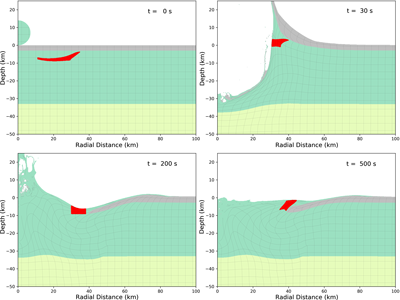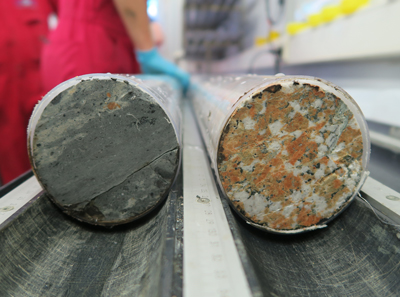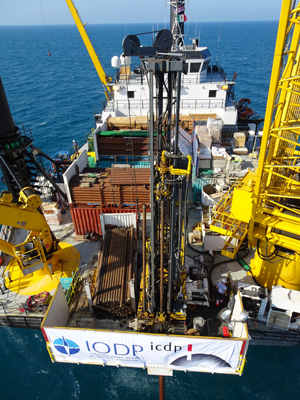
Astronomers have long marveled at the bull’s-eyes outlined in towering rock in many impact craters on planets and satellites in the solar system. As an example to investigate on Earth, scientists have only one crater to turn to: the Chicxulub crater, which intersects the coastline of Mexico’s Yucatán Peninsula.
The extraordinary porosity of drill cores extracted in 2016 from that crater’s peak ring suggests that rocks were moved from great depths to create it, according to Auriol Rae, a geologist at Imperial College London, and his thesis supervisor there, Gareth Collins. They reported their conclusions this month at the General Assembly of the European Geosciences Union in Vienna, Austria. Their latest findings point to the correctness of computer models that have been developed to explain the emergence of peak rings. And they provide guidance for exobiologists looking for life on other planets.
“Chicxulub is the only pristine crater on Earth with an unequivocal peak ring. It is well preserved because it was filled with sediment right after the impact.”“The most famous peak ring crater is on the Moon, the Schrödinger crater,” Rae told Eos. “Chicxulub is the only pristine crater on Earth with an unequivocal peak ring—there are a few more, like Vredefort in South Africa and Sudbury in Canada, but they are quite heavily eroded. Chicxulub is well preserved because it was filled with sediment right after the impact.”
Peak rings are important for planetologists because they indicate that once-buried rocks have been brought to the surface, making them available for inspection by remote sensing or with rovers. The big question has been, From what depth can scientists assume that those geological records emerged?
Transient CavityRae ran a new, detailed physical model of a 14-kilometer object hitting Earth a little less than 66 million years ago at Chicxulub with a velocity of 15 kilometers per second. The most dramatic consequence was probably a worldwide climate catastrophe that doomed the dinosaurs. However, Rae focused on the impactor’s effects on rock directly below the location where it struck. These effects included melting for a relatively small volume under what’s called the target location and displacement for a much larger volume around it.
In the scenario of peak ring creation that Rae’s model tested, first, a shock wave traveled downward and created a huge initial hole, Rae told Eos. This is called the “transient cavity” because such a hole is not stable. The steep sides soon start to slump down while the pressure of the rocks below, no longer counterbalanced, makes the bottom shoot up, much like what happens when a stone is dropped into a pond.
The Chicxulub impactor was so large that this central mountain, which fleetingly exceeded Mount Everest in height, collapsed and broadened.For medium-sized impacts, this process results in a crater with a central peak composed of material that originally was several kilometers under the surface, Rae explained. But the Chicxulub impactor was so large that this central mountain, which fleetingly exceeded Mount Everest in height, collapsed and broadened.
This, Rae’s calculations show, was what brought about the peak ring, as seen in a video he created of the process. It consists of rock that originated 10 kilometers under the surface and was forced to follow a convoluted path, first slumping down along the sides of the transient cavity, then being dragged up with the rising peak, and eventually pushing out and up, over the original surface of the impact site. “It got caught between the uplifted material in the center of the crater and the collapsing crater rim,” Rae explained.
Vertical Cracks
Many geologists accept that this process, called “dynamic collapse,” is how craters get their final configuration, with or without a peak ring, on the basis of computer models, such as Rae’s, of how rocks will behave under impact. But there were other plausible scenarios, such as the “nested melt cavity” model, proposed in 2010 by J. W. Head of Brown University, in which the peak ring rock would be uplifted mostly vertically over a much shorter distance.
 Four stages in the formation of a peak ring according to the dynamic collapse model. Most of the rocks indicated in red start out more than 5 kilometers below the surface (time t = 0 seconds). After an asteroid impact creates a shock wave that pushes these rocks upward and to the side (t = 30 seconds), they slide down with the unstable sides of the “transient cavity” (t = 200 seconds) but eventually are lifted up with material rising from the center (t = 500 seconds) and finally are pushed over the original surface of sedimentary rocks. Credit: A. Rae, Imperial College London
Four stages in the formation of a peak ring according to the dynamic collapse model. Most of the rocks indicated in red start out more than 5 kilometers below the surface (time t = 0 seconds). After an asteroid impact creates a shock wave that pushes these rocks upward and to the side (t = 30 seconds), they slide down with the unstable sides of the “transient cavity” (t = 200 seconds) but eventually are lifted up with material rising from the center (t = 500 seconds) and finally are pushed over the original surface of sedimentary rocks. Credit: A. Rae, Imperial College London
In 2016, scientists got to test their models on actual material from the Chicxulub peak ring, after International Ocean Discovery Program (IODP) Expedition 364, led by Joanna Morgan of Imperial College London and Sean Gulick of the University of Texas at Austin, drilled cores from the site.
The results supported the dynamic collapse model, said Rae, because it turns out that the peak ring consists of granite that is unusually porous, with microscopically small voids making up about 10% of its volume. That much was clear as soon as the researchers on board the drillship Liftboat Myrtle laid eyes on the drill cores. It was also what you would expect from rock that has been forced to move dozens of kilometers while subject to huge shear forces.
 These cores were collected from the peak ring of the Chicxulub crater during IODP Expedition 364. The core on the left is from impact melt rocks, and the core on the right is granitoid basement rock. The granitoid displays both brittle and ductile deformation as a result of the impact-generated shock wave and subsequent movement of these rocks. The orientation of tiny cracks in the rocks caused by that shock and movement agrees with new model calculations of the impact and its aftermath. Credit: Mary Mowat, ECORD/IODP
These cores were collected from the peak ring of the Chicxulub crater during IODP Expedition 364. The core on the left is from impact melt rocks, and the core on the right is granitoid basement rock. The granitoid displays both brittle and ductile deformation as a result of the impact-generated shock wave and subsequent movement of these rocks. The orientation of tiny cracks in the rocks caused by that shock and movement agrees with new model calculations of the impact and its aftermath. Credit: Mary Mowat, ECORD/IODP
At the Vienna meeting, Rae presented new findings that suggest that the computer models are really close to the mark. He established that cracks in the granite run predominantly in a direction close to vertical. And this direction is precisely how his computer model predicts those cracks will be oriented on the basis of the path the rock takes to the surface and the forces it encounters.
Challenge on Other Planets“If the interpretations are correct, then this model can help to explain the formation of rings of mountains inside the largest craters on planetary bodies,” David Hollibaugh Baker told Eos via email. He’s a planetary geologist with the Planetary Geology, Geophysics, and Geochemistry Laboratory at NASA Goddard Space Flight Center in Greenbelt, Md., and was not involved with the study. “The ultimate test of this model, however, is to correctly simulate similar basin structures on other planetary bodies such as the Moon and Mercury with different crustal properties, impactor conditions, and gravitational accelerations. These all influence the formation of impact basins and can be used to further challenge, test, and refine simulations of large impact craters.”
 View of the drillship Liftboat Myrtle, from the drill rig at the bow, during IODP Expedition 364 to take cores from the peak ring of the Chicxulub crater. Credit: D. Smith, ECORD/IODP
View of the drillship Liftboat Myrtle, from the drill rig at the bow, during IODP Expedition 364 to take cores from the peak ring of the Chicxulub crater. Credit: D. Smith, ECORD/IODP
Once planetologists have a model that is shown to be robust, Baker continued, “this will aid in understanding the provenance and shock state of uplifted rocks, some of which might be sampled by future landed missions searching for insight into deep crustal layers and the formational history of a planetary body.”
Geologist Pim Kaskes from the Free University of Brussels, who was in Vienna to present a study of other rocks thrown up by the Chicxulub impact, says he was awed by the range of scales that Rae’s study encompasses: “It’s very cool to see how you have a crater of almost 200-kilometers diameter, and he is looking at rock characteristics measured in micrometers to explain it.”
The result is promising not only for geologists who want to understand peak ring craters but also for exobiologists, said Rae. Because the peak ring rocks are so porous, they could, on some planets, be the primary locations where water is transported to and from deep, hot layers. “Peak rings are thought to be very important in terms of hydrothermal activity within impact structures. And hydrothermal systems are thought to be very important for the habitability of places for life.”
—Bas den Hond (email: bas@stellarstories.com), Freelance Journalist
The post New Simulation Supports Chicxulub Impact Scenario appeared first on Eos.
from Eos https://eos.org/articles/new-simulation-supports-chicxulub-impact-scenario?utm_source=rss&utm_medium=rss&utm_content=new-simulation-supports-chicxulub-impact-scenario
via IFTTT
